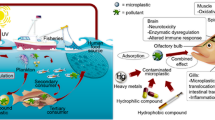Abstract
The marine phytoplankter Dunaliella peircei was exposed to a concentration of 10.00μg/l of the chlorinated hydrocarbon insecticide dieldrin in sea-water solution. After 24 h exposure, the dieldrin residue level in the alga was 12.10μg/g, corresponding to a magnification factor of 1210. Clams, Rangia cuneata, allowed to feed on dieldrin-contaminated phytoplankters for 48 h exhibited a magnification of dieldrin residues in tissues up to 54 times greater than the concentration resulting from the resuspension of contaminated algal cells in clean seawater. This study demonstrates the transfer of dieldrin residues in a two-level food chain, i.e., from a contaminated alga to a bivalved mollusc allowed to feed on this alga.
Similar content being viewed by others
Literature Cited
Bøhle, B.: Effects of adaptation to reduce salinity on filtration activity and growth of mussels (Mytilus edulis L.). J. exp. mar. Biol. Ecol. 10, 41–47 (1972)
Butler, P.A.: Organochlorine residues in estuarine mollusks, 1965–72-National Pesticide Monitoring Program. Pestic. Monit. J. 6, 238–362 (1973)
Darnell, R.M.: Food habits of fishes and larger invertebrates of Lake Pontchartrain, Louisiana, an estuarine community. Publs Inst. mar. Sci. Univ. Tex. 5, 353–416 (1958)
— Trophic spectrum of an estuarine community, based on studies of Lake Pontchartrain, Louisiana. Ecology 42, 553–568 (1961)
— Ecological history of Lake Pontchartrain, an estuarine community. Am. Midl. Nat. 68, 434–444 (1962)
Giam, C.S., A.R. Hanks, R.L. Richardson, W.M. Sackett and M.K. Wong: DDT, DDE, and polychlorinated biphenyls in biota from the Gulf of Mexico and Caribbean Sea-1971. Pestic. Monit. J. 6, 139–143 (1972)
Hopkins, S.H.: Studies on brackish water clams of the genus Rangia in Texas. Proc. natn. Shellfish. Ass. 60, 5–6 (1970)
— and J.D. Andrews: Rangia cuneata on the east coast: thousand mile range extension, or resurgence? Science, N.Y. 167, 868–869 (1970)
Jensen, S., A.G. Johnels, M. Olsson and G. Otterlind: DDT and PCB in marine animals from Swedish waters. Nature, Lond. 224, 247–250 (1969)
Menzel, D.W., J. Anderson and A. Randtke: Marine phytoplankton vary in their response to chlorinated hydrocarbons. Science, N.Y. 167, 1724–1726 (1970)
Menzie, C.M.: Metabolism of pesticides. Spec. scient. Rep. U.S. Fish Wildl. Serv. (Wildl.) 127, 1–487 (1969)
Nash, R.G. and E.A. Woolson: Persistence of chlorinated hydrocarbon insecticides in soil. Science, N.Y. 157, 924–927 (1967)
Neary, M.P.: Nuclear laboratory experiment manual, 132 pp. Fullerton, California: Beckman Instruments, Inc. 1971
Nimmo, D.R., A.J. Wilson, Jr. and R.R. Blackman: Localization of DDT in the body organs of pink and white shrimp. Bull. envir. Contam. Toxicol. 5, 333–340 (1970)
Petrocelli, S.R., J.W. Anderson and A.R. Hanks: Biomagnification of dieldrin residues by food-chain transfer from clams to blue crabs under controlled conditions. Bull. envir. Contam. Toxicol. 13, 108–116 (1975)
—, A.R. Hanks and J.W. Anderson: Uptake and accumulation of an organochlorine insecticide (dieldrin) by an estuarine mollusc, Rangia cuneata. Bull. envir. Contam. Toxicol. 10, 315–320 (1973)
Reinert, R.E.: Accumulation of dieldrin in an alga (Scenedesmus obliquus), Daphnia magna, and the guppy Poecilia reticulata. J. Fish. Res. Bd Can. 29, 1413–1418 (1972)
Rice, C.P. and H. Sikka: Fate of dieldrin in selected species of marine algae. Bull. envir. Contam. Toxicol. 9, 116–123 (1973a)
—: Uptake and metabolism of DDT by six species of marine algae. J. agric. Fd Chem. 21, 148–152 (1973b)
Risebrough, R.W., R.J. Huggett, J.J. Griffin and E.D. Goldberg: Pesticides: transatlantic movements in the Northeast Trades. Science, N.Y. 159, 1233–1235 (1968)
Robinson, J., A. Richardson, A.N. Crabtree, J.C. Coulson and G.R. Potts: Organochlorine residues in marine organisms. Nature, Lond. 214, 1307–1311 (1967)
U.S. Department of Health, Education and Welfare-Food and Drug Administration: Pesticide analytical manual, Vol. 1. Washington, D.C.: U.S. Government Printing Office 1969
Von Stosch, H.A.: Wirkungen von Jod und Arsenit auf Meeresalgen in Kultur. Proc. int. Seaweed Symp. 4, 142–150 (1964)
Weaver, L., C.G. Gunnerson, A.W. Breidenbach and J.J. Lichtenberg: Chlorinated hydrocarbon pesticides in major U.S. river basins. Publ. Hith Rep., Wash. 80, 481–493 (1965)
Wheeler, W.B.: Experimental absorption of dieldrin by Chlorella. J. agric. Fd Chem. 18 416–419 (1970)
Woodwell, G.M., C.F. Wurster and P.A. Isaacson: DDT residues in an east coast estuary: a case of biological concentration of a persistent insecticide. Science, N.Y. 156, 821–824 (1967)
Wurster, C.F.: DDT reduces photosynthesis by marine phytoplankton. Science, N.Y. 159, 1474–1475 (1968)
Author information
Authors and Affiliations
Additional information
Communicated by J.S. Pearse, Santa Cruz
Rights and permissions
About this article
Cite this article
Petrocelli, S.R., Anderson, J.W. & Hanks, A.R. Controlled food-chain transfer of dieldrin residues from phytoplankters to clams. Mar. Biol. 31, 215–218 (1975). https://doi.org/10.1007/BF00387149
Accepted:
Issue Date:
DOI: https://doi.org/10.1007/BF00387149




